- 1. Twin-bar tunes (ex.1-11, №1-58)
- Twin-bar tunes based on the g,-c bichord
- Twin-bar tunes based on rotating motifs
- Twin-bar tunes with descending/hill-shaped lines
- Motifs with a downward leap at the end of the line
- Motivic processes
- 2. Tunes moving on Ionian scales (ex.12-24, №59-164))
- Laments and their relatives
- Two-lined tunes of Major character with higher main cadences and their four-lined relatives
- Four-lined tunes of Major character
- 3. Aeolian tunes (ex.25-36, №165-238)
- Laments and related tunes
- Aeolian tunes with higher main cadence
- Four-lined tunes of Minor character
- Valley-shaped, ascending or undulating first line
- 4. Caramazan religious tunes (ex.37-41, №239-326)
- 5. Tunes of domed structure (ex.42-43, №327-332)
8. A Musical Map of Different Turkic-Speaking Peoples
- as Based on Field Work from 1936 until the Present
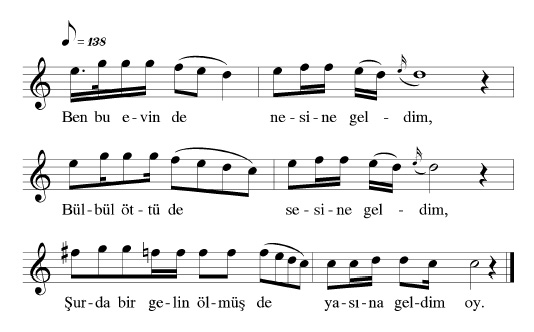

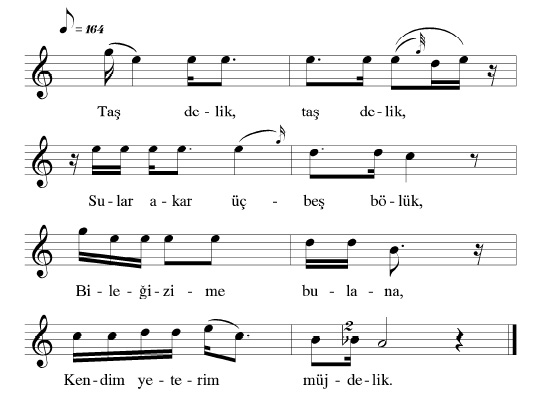

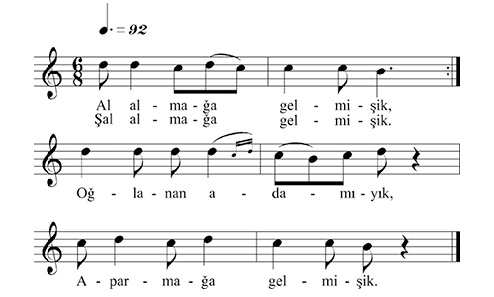

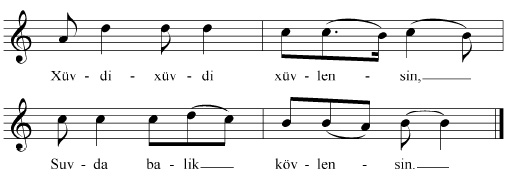

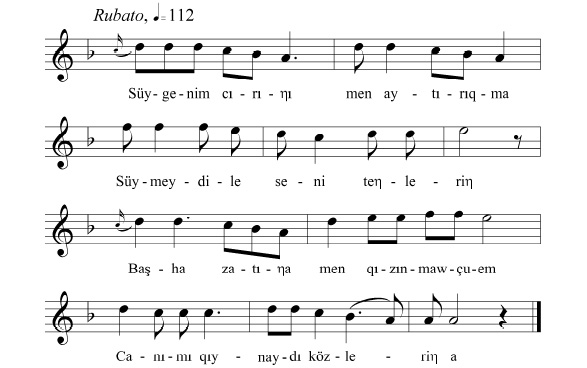

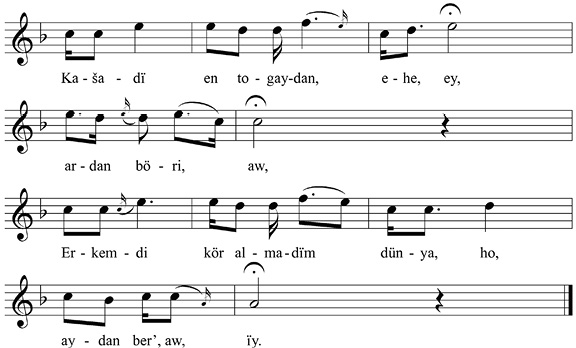



Due to lack of space and time I cannot introduce all of the folk music styles belonging to each of the Turkic peoples, studied by myself peoples ; I can only describe with broad brushstrokes one or two important musical layers.
Let us start in Turkey. The ethnogenesis of this nearly 80 million people is highly complex and its folk culture is accordingly very diverse. Many musical forms are found here, from motives moving on a few tones to four-line structures spanning almost two octaves.
Here we see great differences according to areas or genres, for example the secular folksongs of the Sufi Tahtadji people are based on a single musical phrase, while their religious repertoire includes a number of very different forms. However, developing an overview of Anatolian folk music is not hopeless. Béla Bartók tried it, and so did I later on using a much larger amount of material. (Bartók 1936; Sipos 1994, 1995, 2001b and 2005)
Now I will introduce two major forms. The essential structure of the most widely distributed Turkish laments is two freely and flexibly improvised sections moving parallel to each other on a major hexachord (ex.44). Such laments occur in Bulgarian, Hungarian and Spanish folk music and in Gregorian chant as well. (Dobszay 1983, Sipos 2006c) However, the lament repertoires of several peoples have completely different characteristics, so in this case we cannot think of a form born from some “universal” human soul regardless of culture.

Example 44 Anatolian lament (Sipos 1994: №43)
Another important form in Anatolia is a special four-line descending structure. The musical sections cadence on the 5th, b3rd, b3rd and 1st degrees of the Aeolian scale with characteristic movement around the E-D-C trichord in the middle of the melody (ex.45). This type of melody can be found in the folk music of the south-western Kazakhs, Karachays (mainly in the religious repertoire) and that of the Hungarian Seclers. (Dobszay-Szendrei 1988, Sipos 2001b, 2006a)
However, it is rare or nonexistent in the folk music of many other Turkic peoples.

Example 45. Anatolian ’psalmodic’ melody (Sipos 1994: №79)
Now let us move eastward toward the Azeris, the closest linguistic relatives of Anatolian Turks. The territory of Azerbaijan was Turkicized by the same Turkmen tribes as Anatolia, but they merged with a different base layer (substratum), which may explain the differences in their folk music systems.
In contrast to the complexities of Anatolian folk music, Azerbaijani folk music presents a very simple picture. Its tunes range from three to four tones (Aeolian, Dorian, and Phrygian tri- or tetrachords), are composed of short sections in duple meter, either 6/8 or 2/4, and here the four-section strophic form is extremely rare. (Sipos 2004a, 2006b, 2009)
Similar melodies can only be found in the eastern part of Turkey among the Azeri and Kurdish populations living here. If we want to characterize Azeri folk music with a single melody it would be the following. (ex.46)

Example 46. A typical Azeri melody (Sipos 2004a: №145)
Let us now take a look at the folk music of the Turkmens who live on the other side of the Caspian Sea. According to my own research among them and the various published sources I consulted, the melodies of village Turkmens are very simple, showing a great resemblance to Azerbaijani folksong. (Beliaev 1975, Sipos 2012) In contrast to this, the repertoire of the semi-professional Turkmen bahşis ‘minstrels’ is much broader and worth investigating. The fourth example is a typical Turkmen folk song. We can see how well it fits the general characteristics of Azerbaijani tunes. (ex.47)

Example 47. A typical Turkmen folk song
(János Sipos’s Turkmen expedition in 2011, Etrek)
Let us proceed northward to the land of the Karachay-Balkar people, also close to Azerbaijan but separated from it by the impenetrable peaks of the Caucasus Mountains. The northern side of the Caucasus is very important scenery for Hungarians as well as for many Turkic peoples because it is where the steppe narrows considerably. Westward migrating peoples such as the Huns, Avars and Hungarians passed through it from the 4th century on.
The complexity of Karachay folk music parallels that of the Karachay ethnogenesis. In stage performances here, we hear all-Caucasian dance music played on the accordion or garmon while dancers toddle around on their toes doing dances created during the Soviet era. In village celebrations and weddings the music is similar but the dances are more archaic, though they also have a kind of pan-Caucasian character.
Karachay folk music, although not as rich as that preserved in Anatolia, contains many forms. However, at least in their current folk repertoire, simple songs are underrepresented, while many complex four-line melodies exist. The Karachays have a melody class called ‘ǰir’ with a special text division they consider to be typically Karachay. However, this form and these kinds of melodies can be heard among Kabards as well, and it is so untypical among Turkic people that we may safely consider that it was taken over from the Kabards. Let us look now to one of these tunes (ex.48). (Otarov 2001, Sipos – Tavkul 2012)

Example 48. Karachay ǰir melody (Sipos-Tavkul 2012: ex.12.2)
If we continue our bird’s eye tour to have a look at the music of the Turkic peoples living in the Volga-Kama region, we perceive a musical world of surprisingly different characteristics. Tatar, Bashkir and Chuvash folk music is characterized by melodies descending exclusively on pentatonic or sub pentatonic scales. Here emerges a special fifth-shifting melodic form with the first half a fifth higher than the second part. This characteristic phenomenon can be heard only around the Chuvash-Cheremiss boarder within a 100 kilometre radius. However, these melodies exist among the Finno-Ugric Cheremiss people where Chuvash Turkic linguistic effect is observed.
In the almost entirely pentatonic Tatar folk music we see the shift of a fourth instead of a fifth. Pentatonic fifth shifting can be heard in great quantity also in Outer and Inner Mongolia, so in the case of fifth-shifting in the Volga-Kama region we might suspect the influence of Mongol people merging here during and after the era of the Golden Horde. (Sipos 2001a)
This hypothesis is also strengthened by the similarity of the Bashkir-Tatar uzun kuy and the urtin duu melodies of the Mongols. Moreover, the Mongols wielded a considerable linguistic effect on Volga Kipchak languages in the same time period mentioned above. (Csáki 2006, Vikár 1993)
It should also be mentioned that among Turkic peoples we only see pentatonic scales in China (Uyghurs), in Mongolia, in the northern regions of Kazakhstan and in the Volga-Kama region and in Siberia. The music of the Turkic people living south of this strip is characterized by diatonic tunes usually having a narrower compass.
There have been several research expeditions in the huge area of Kazakhstan, but comprehensive comparative work has not yet begun. (Erzakovich 1966, 1979, 1995). I did compare the music of the south-western Aday Kazaks to that of the Mongolian Kazaks. (Sipos 2001c) It turned out that even though their language is basically the same, the music of the Mongolian Kazakhs is characterized by pentatonic melodic lines with up and down undulating movements in contrast to the descending Aday Kazakh melodies moving on small compass diatonic scales. At the same time, Mongolian Kazakh melodies are different from the also pentatonic Mongolian tunes as well (ex.49a-b).
The Aday Kazaks have more psalmodic tunes than the Azeris, but fewer than the Anatolian Turks or the Hungarians. In general Aday Kazaks have more and quite diverse melody styles than Azeris, and these melodies are different from the pentatonic music styles of the Mongolian Kazakhs.
a)

b)

Example 49. a) Aday Kazakh ’psalmodic’ melody (Sipos 2001: №13a) and b) a typical Mongolian Kazakh melody (Sipos 2001: №b7a)
As we saw Kyrgyz music resembles that of the Karachay in complexity, but there are many more basic forms in the former. The folk music of the Siberian Turks (Saha, Tuvan, Altay Kishi, Xakas, etc.) have been gathered and published in Novosibirsk.
Viktor Sergeevich Vinogradov (1958), a specialist of Kyrgyz music charted a summary of the Inner Asian Turkic folk music. The map contains basic connection but it should be taken into account that he considered, professional, semi-professional and rural folksongs alike. That may underlie the startling fact that Kazakhs and Turkmens are in the same group.
Group 1 contains the Azeris closely tied to Caucasian traditions. Group 2 includes the northern groups: Tatars, Bashkirs, some Altay Turks, Oirats, Tuvans, whose music is closely linked to the musical practice of Mongols, Buryats and Chuvash people. Group 3 contains the Uzbeks with their Tajik relations. Group 4 involves the Kazakhs and Turkmens, while the last, 5th group contains the Kyrgyz, Khakas and several Altaic tribes. For their common nomadic background groups 4 and 5 display several common features.
|
2. Tatar, Bashkir, some Altay Turkic, Tuva (Mongol, Oirat, Buryat, Chuvash) |
|||
|
1. Azeri (~Caucasus) |
↔ |
4. Kazakh ↔ Turkmen |
5. Kyrgyz, Khakas and several Altaic tribes. (4~5) |
|
3. Uzbek~Tajik |
Map 2. A map of Turkic folk musics
However it is perhaps Gippius (1964) who summed up the current stage of such typologies most incisively: “It is still a matter of the future to have a historical dissertation that carries out the comparative examination of the national musics of Tuvans, the Turkic peoples living in the areas of the Altay, the Ural, the Volga area and their relations in Central Asia, as well as the Mongols and Buryats. At present there are not enough publications for this research in the literature of Soviets or other peoples.” (see also Slobin 1969a: xiii)
